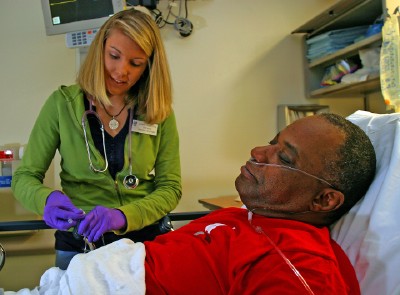BWH Completes Successful Joint Commission Survey

Jennifer Meech and staff spoke with Joint Commission surveyors about patient care in the ED.
The commitment of BWH’s nursing staff to excellent care to patients and families with the best staff in the safest environment impressed the team from The Joint Commission that came to BWH in February to conduct the hospital’s accreditation survey.
Several Department of Nursing Quality Program efforts made the list of best practices, which The Joint Commission shares with other hospitals. Specifically, surveyors praised BWH’s efforts to reduce use of patient restraints, the process for opening the surge pod and implementation of the World Health Organization (WHO) checklist in the OR.
“Our nursing staff are involved in many quality improvement efforts, and The Joint Commission Survey and our preparation for it provide an opportunity to demonstrate nursing’s ongoing commitment to quality and safety and how these principles are integrated into practice,” said Diane Lancaster, PhD, RN, executive director of Quality Measurement and Improvement.
The six-person survey team used The Joint Commission’s tracer methodology and followed dozens of patients to approximately 50 departments and units throughout the Shapiro Center, Tower, Connors Center, Emergency Department, Pharmacy, operating rooms, procedure areas, 221 Longwood Ave., Brigham and Women’s/Mass General Health Care Center at Foxborough, Brigham and Women’s Ambulatory Care Center at 850 Boylston St. and Southern Jamaica Plain Health Center.
In preparation for the survey, unit-based leadership and quality program directors staged mock tracers at least monthly for months in advance.
In the Emergency Department, clinical staff nurse Jennifer Meech, BSN, RN, spoke with a surveyor about caring for patients with mental health and behavioral health needs. “The surveyor was very receptive to hearing about how we have implemented new behavioral health packets and mentioned that they hoped to share our model with other hospitals and other emergency departments.”
In the OR, implementation of the WHO safety check list also impressed surveyors. The checklist identifies three phases of an operation: before the induction of anesthesia, before the incision of the skin or “time out” and before the patient leaves the operating room or “sign out.” Staff nurses, the anesthesiologist and surgeon all participate in completing the listed tasks before proceeding with the operation.
“Our surveyor, a surgeon himself, was impressed that we have been using the checklist for a year and that it was in place in all our ORs,” said Kristin Alt Styer, MSN, RN, quality program director for Preoperative Nursing. “All three disciplines – anesthesiology, surgery and nursing – demonstrated a high level of attention to detail and commitment to communication, which happens every day here.”
Such exchanges between staff and surveyors happened throughout the survey. “Overall, the survey process allowed staff to engage in conversation about the care they provide and the pride they have in BWH as a good place to practice,” said Lancaster.
Moving forward, the Department of Nursing will be collaborating with other disciplines and departments to continue to improve patient safety. Examples include:

Kristin Alt Styer and other OR clinicians engaged Joint Commission surveyors in conversation about BWH’s use of the WHO safety checklist.
Working with Pharmacy to transition from IV bolus to IV push drug administration where appropriate; Pharmacy will now admix the majority of products needed under more sterile conditions.
Changing three questions on the nursing admission assessment relative to when a physical therapy consult may be needed;
Improving compliance with sign, date and time documentation on progress notes, event notes and nursing notes;
Aligning physician and nurse medication allergy/sensitivity information when patient provides differing accounts to physicians and nurses;
Ensuring date and time is marked on containers of saline and sterile water in warming cabinets in the OR and procedure areas.